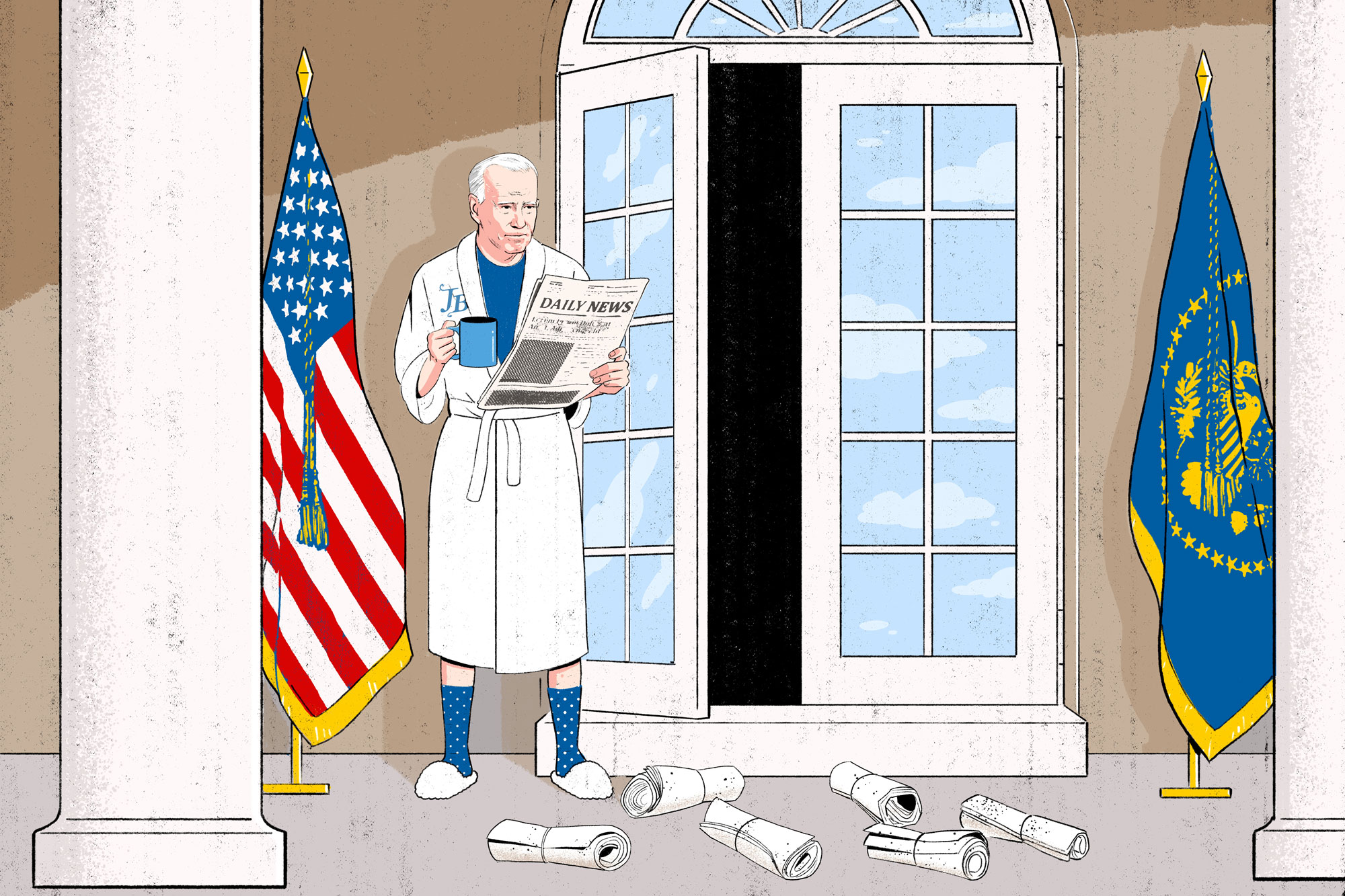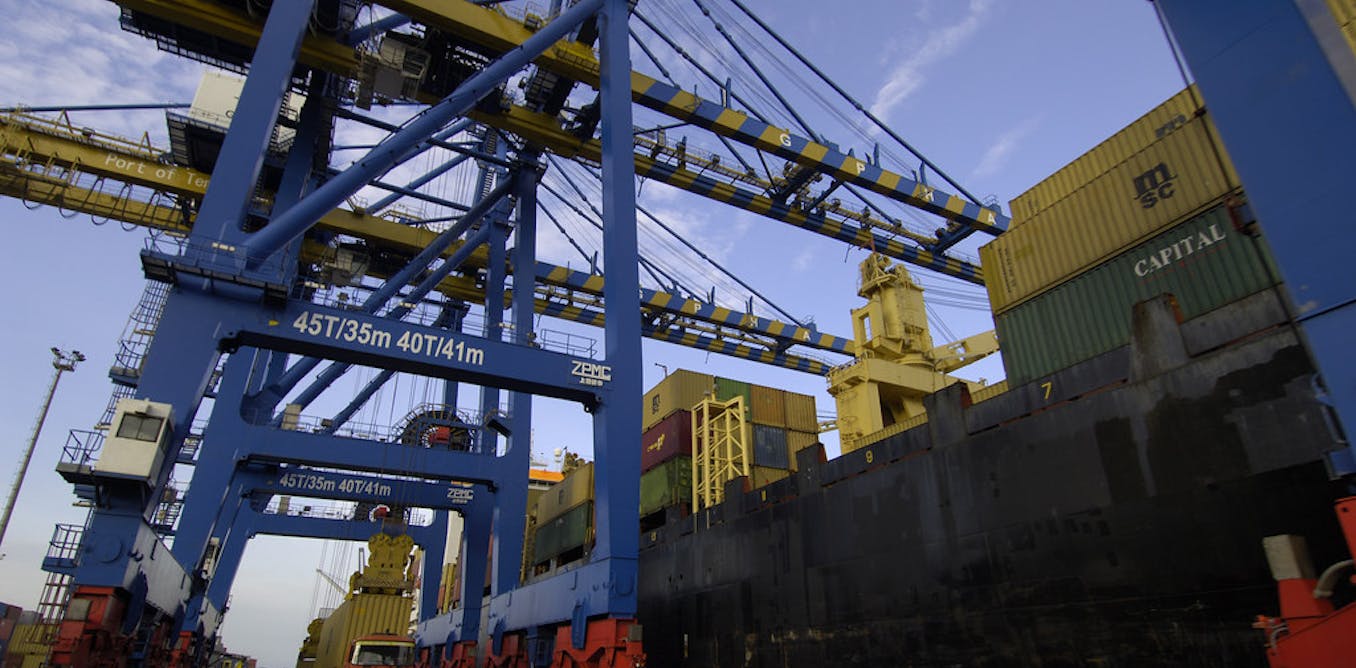His Morning Routine: Exercise With a Side of Morning Joe!
Aides say the president isn’t a religious viewer of any particular cable news show. But if there’s one he watches with regularity, it’s Morning Joe. Unlike Trump, who started tweeting before most of Washington awoke, Biden typically isn’t watching that first 6 a.m. hour — or rage-tweeting about Mika — but he will often tune in while riding his exercise bike around 7 a.m. And we’re told he’s occasionally in touch with some of the hosts and has, at times, conveyed positive feedback about what they’ve said. For instance, he let Joe Scarborough know that he enjoyed his description of Sen. Ron Johnson (R-Wisc.) as “having rocks in his head.”
There’s a Tiny TV in the Oval Office
When people step into the Oval Office, they might notice the five presidential portraits hung over the fireplace or the grandeur of the historic Resolute Desk — but not the little television. That’s the point. The TV monitor sits behind Biden on another desk topped with picture frames, encased in a golden frame itself so as to be inconspicuous. But when there aren’t press cameras or dignitaries in there, the 10 or 12” screen is often turned on — and tuned to CNN. While Biden isn’t spending hours in his private dining room glued to a big screen as his predecessor was, several current and former White House officials told me that the president will keep an eye on his secret screen behind his desk and react to coverage during less formal meetings with staff. Televisions outside the Oval and aboard Air Force One are also almost always on CNN during the day, not “the quad,” the four-box available in the building to staffers who want to keep an eye on all of the main cable networks simultaneously.
He Calls People He Sees on TV
The way to ingratiate yourself with Trump was simple: just say nice things about him on TV. Biden is not as insecure — and easily won over — as his predecessor, but he has been known at times to pick up the phone to personally thank people articulating helpful messages on television, be they hosts (Al Sharpton has gotten such calls) or panelists. Last summer, as Democrats’ big spending package was languishing in Congress, Biden called Jim Messina after seeing him on MSNBC defending the administration’s agenda. According to people familiar with these calls, Biden will often solicit feedback or advice from the journalists and politicos he dials up.
And He Has His Favorites
It’s safe to say Biden isn’t up late in the Lincoln bedroom chatting with Sean Hannity after his show. The president’s closest relationships with members of the media are with his contemporaries, the reporters and commentators he’s been reading and interacting with since his years in the Senate. The group includes Times columnists David Brooks and Thomas L. Friedman, both of whom have had audiences with Biden at times, and Mike Barnicle, the Morning Joe regular and longtime columnist. He has also maintained a relationship with the New Yorker’s Evan Osnos, who turned a lengthy interview with Biden during his campaign’s early, quarantined basement days into a book. He has occasionally talked foreign policy with Friedman, who got to know Biden when he was a senator on a 10-day trip to the Middle East. Earlier this year, Friedman even succeeded in getting Biden to issue him a short statement — on a Saturday! — about pro-democracy demonstrations in Israel, which he used in a column. “This is the first time I can recall a U.S. president has ever weighed in on an internal Israeli debate about the very character of the country’s democracy,” he wrote.
He Is a Print Guy
Biden has the same push alerts on his cell phone we all do, but he is a traditionalist when it comes to newspapers. When he took office in 2021, he asked aides to make sure the print editions of the New York Times, Washington Post and Wall Street Journal were available to him in the White House residence and the West Wing, according to several administration officials. The papers are delivered very early in the morning to the executive residence staff and the West Wing, the officials said. No one has yet seen him autographing news clippings with a Sharpie and sending them to pals.
He Reads His Own Clips (Like Everyone Else in Washington)
Every White House compiles daily clips for the president and top aides. But we’re told Biden is particularly interested in the local news people across the country are reading. When he flies home after an event, staffers aboard Air Force One print out stories by local outlets that covered his appearances for him to read on the plane. And every day inside the West Wing, the staff secretary’s office puts together a binder of national and local news clips and front pages, including from Black, Latino and AAPI-focused outlets. Aides who have spent time around the president also said that he’ll often note an article referenced during a cable news segment and ask a staffer to print it out for him. When he was vice president, his clips also included news stories from Delaware, and we’re told he still keeps tabs on local happenings.
But He Doesn’t Love the Coverage
In his occasional comments to reporters, Biden has betrayed a frustration with the media’s coverage of him writ large, complaining that “you guys” probably won’t cover what cause or topic he’s eager to talk about at that moment. (In several instances, he has refused to respond to shouted questions on topics unrelated to the event at which he’s speaking.) Aides, concerned in part about the president’s ability to hear shouted questions beneath the whir of Marine One’s rotor blades, have tried to limit situations where the president is confronted — and perhaps enticed to engage — by a horde of shouting reporters. Unlike many of his predecessors, Biden has cultivated few relationships with reporters through off the record meetings and conversations. And the only time he has visited the press cabin aboard Air Force One, something Trump did with regularity, his off-the-record comments included complaints about his coverage. He has rarely griped publicly about any specific report, but some have gotten under his skin — including a story last summer by the New York Times’ Peter Baker about his age becoming “an uncomfortable issue,” multiple people around the president confirmed.
While the president has affirmed the importance of the press’ independence and its role in a democracy — (you’ll hear no “enemies of the people” rants from him) — he often grumbles privately that news coverage is too focused on his predecessor and other fleeting controversies and believes that the media has failed to focus on the historic nature and real world impact of his legislative accomplishments. He also complains to staffers, especially those who oversee communications, not enough people defend him on cable television, something those plotting his reelection campaign are hoping to remedy with a more robust surrogate operation.




